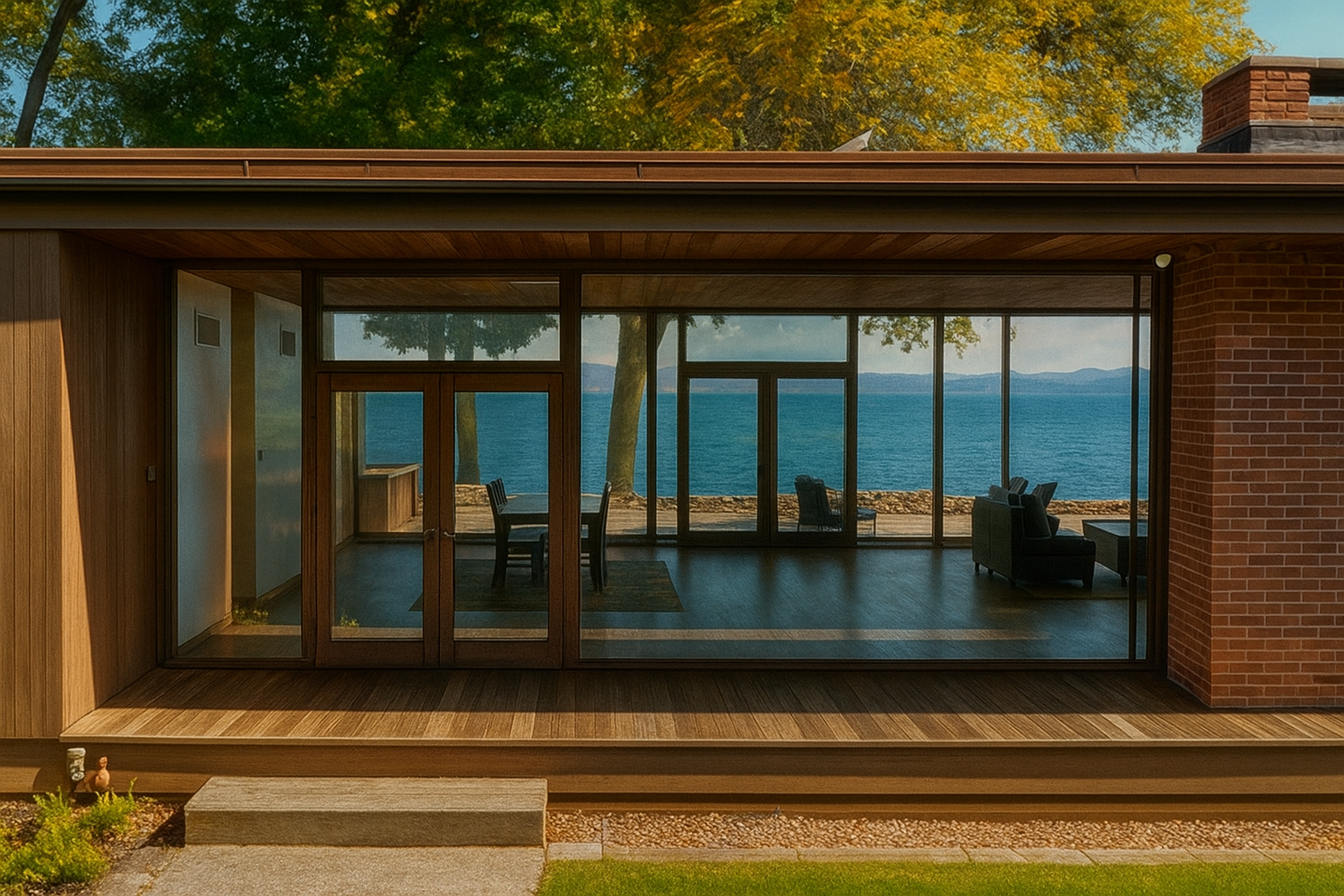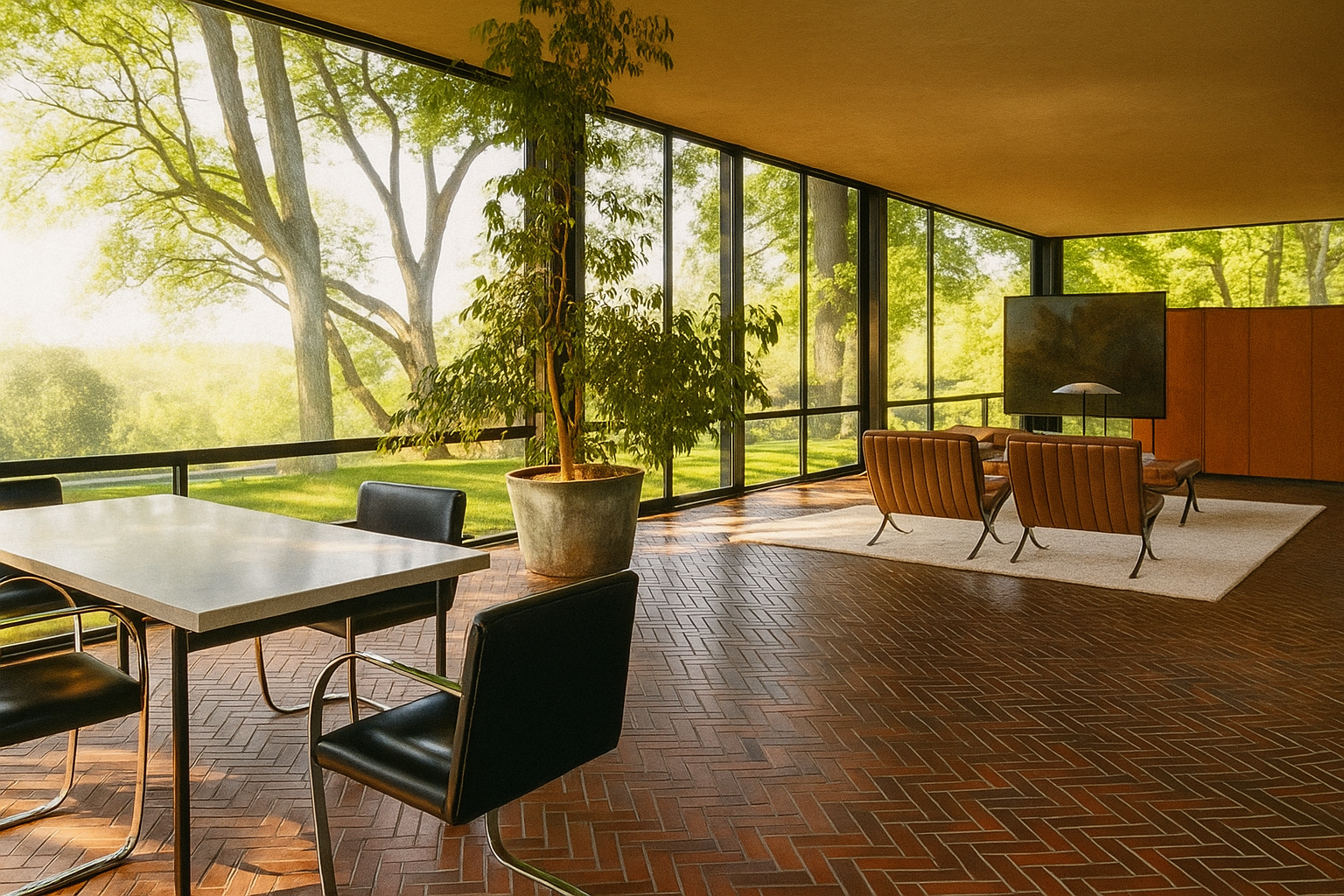Philip Johnson — The Master of Glass and the Architect of American Modernism
Introduction: The Designer Who Made Modernism a Movement
Few figures have shaped the course of American architecture as profoundly as Philip Johnson. Equal parts visionary, provocateur, and tastemaker, Johnson helped define — and redefine — the direction of modern design throughout the 20th century.
From his Glass House in New Canaan, Connecticut to monumental works like the Seagram Building in New York, Johnson’s career spanned seven decades of innovation. He introduced America to modernism, then pushed beyond it, blending art, architecture, and philosophy into a body of work that remains both influential and controversial.
Johnson’s designs — clean, geometric, and expressive — helped popularize the ideals that would become Mid-Century Modern architecture: transparency, simplicity, and the seamless fusion of structure and landscape. His impact continues to echo throughout California Modern design, inspiring homes that celebrate openness, proportion, and light.
Design Philosophy: Geometry, Transparency, and the Theater of Space
Philip Johnson’s approach to design was rooted in clarity, composition, and contrast. He was fascinated by the relationship between structure and emotion — how simple forms could evoke beauty, drama, and meaning.
As one of the first architects to champion the International Style, Johnson initially embraced steel-and-glass minimalism, believing that “architecture is the arrangement of space for exciting effects.” Yet throughout his career, he constantly evolved — moving from rational modernism to expressive postmodernism, always guided by a deep understanding of history and proportion.
Core Principles of Johnson’s Architectural Vision
Transparency and Reflection: Walls of glass that merge interior and exterior worlds.
Simplicity and Geometry: Pure forms — squares, rectangles, and circles — used with discipline and precision.
Material Expression: Honest use of steel, glass, and concrete to define modern aesthetics.
Spatial Drama: Architecture as experience — balanced between logic and emotion.
Integration with Nature: Buildings that frame views, embrace landscapes, and let light shape atmosphere.
Johnson’s work made modernism approachable, elegant, and profoundly human. His ability to combine intellectual rigor with visual beauty helped make the modern home both accessible and desirable.
Notable Projects & Architectural Highlights
The Glass House (New Canaan, Connecticut, 1949)
One of the most famous residences of the 20th century, the Glass House distilled the essence of modernism into a single, transparent volume. Inspired by Mies van der Rohe’s Farnsworth House, it’s both austere and poetic — a perfect union of structure, proportion, and landscape.
Seagram Building (New York, 1958)
Designed with Mies van der Rohe, the Seagram Building is a monument of corporate modernism. Its bronze and glass facade set a new global standard for skyscraper design, defining the modern urban skyline for decades.
AT&T Building (New York, 1984)
A bold departure from modernist orthodoxy, Johnson’s AT&T Building (now 550 Madison Avenue) ushered in the era of postmodernism. Its “Chippendale” top and classical references reintroduced wit and ornament into architectural design.
Kreeger Museum (Washington, D.C., 1967)
This refined concrete and glass structure balances monumentality with intimacy, revealing Johnson’s ongoing interest in material contrast and controlled light.
Los Angeles Architecture and Influence
While Johnson designed few residential projects in California, his influence is deeply felt across the California Modern landscape — in the open glass-walled homes of Pierre Koenig, the sculptural forms of John Lautner, and the formal clarity of Richard Neutra. His aesthetic vocabulary helped define the architectural DNA of Mid-Century Modern homes throughout the West Coast.
Philip Johnson’s Influence on Mid-Century Modern Homes
Johnson’s Glass House became one of the most influential residences in modern architectural history. It introduced an entirely new way of living — open, minimal, and transparent — influencing generations of architects and homeowners.
His ideas resonated deeply with California’s modernist movement, where architects like Eichler, Anshen & Allen, and Koenig adapted his concepts of lightness, proportion, and openness for suburban living. The result was a uniquely Californian version of modernism — homes designed for community, sunlight, and connection to the outdoors.
Today, Johnson’s principles continue to shape Mid-Century Modern renovations and restorations across California, as homeowners rediscover the timeless appeal of:
Floor-to-ceiling glass walls.
Open-plan living centered around landscape.
Minimalist geometry balanced with warmth and texture.
Honest materials that reveal craft and clarity.
To explore homes inspired by the architectural ideals of Philip Johnson and the modernists he influenced, visit EichlerHomesForSale.com.
The Boyenga Team: Advocates for California Modernism
The Boyenga Team, the Bay Area’s leading experts in Mid-Century Modern and architectural real estate, share Philip Johnson’s belief that architecture is an art form meant to be experienced and lived. Their work connecting buyers and sellers of California Modern homes helps preserve the legacy of visionary architects who shaped the modern age.
Why the Boyenga Team Are Leaders in Modern Real Estate
Specialization in architectural properties, from Eichler and Neutra to Koenig, Lautner, and Johnson-inspired designs.
Expertise in marketing Mid-Century Modern homes to design-savvy buyers.
Deep appreciation for architectural heritage and restoration authenticity.
Commitment to preserving California’s modernist legacy for future generations.
Like Johnson, the Boyenga Team understands that great design transcends style — it’s about proportion, experience, and the way light transforms space. They treat every home as a piece of architectural history, curating and presenting properties with the respect they deserve.
Explore architectural listings, modern design resources, and curated Mid-Century Modern homes at BoyengaTeam.com and EichlerHomesForSale.com.
Lasting Legacy & Modern Market Relevance
Philip Johnson’s career defined the narrative of American modern architecture — from the disciplined purity of early modernism to the expressive experimentation of postmodernism. His willingness to evolve, provoke, and inspire set him apart as both architect and cultural curator.
In today’s Mid-Century Modern real estate market, homes that reflect Johnson’s aesthetic — minimalist geometry, open glass volumes, and integrated landscapes — remain among the most sought-after. Collectors and design enthusiasts prize these properties for their enduring sophistication and architectural clarity.
The Boyenga Team’s dedication to promoting and protecting California’s modern architectural heritage ensures that Johnson’s spirit — and the movement he helped ignite — continues to thrive in the Bay Area and beyond.
In Summary
Philip Johnson was more than an architect; he was a storyteller of modern space. His Glass House distilled the modernist dream — transparency, harmony, and the art of simplicity — into a timeless architectural experience.
Through visionaries like Johnson, and stewards like the Boyenga Team, the legacy of Mid-Century Modern architecture lives on — not just in museums or textbooks, but in the homes where people continue to live with light, proportion, and grace.
Discover authentic Mid-Century Modern and California Modern homes at BoyengaTeam.com and EichlerHomesForSale.com — your trusted partners in design-inspired real estate and modern living.
Contact Us and Begin Your Mid Mod Journey Today!
Boyenga Team + Compass Eric & Janelle Boyenga 📞 Call / Text : 408-373-1660 📧 Email : Eichlers@Boyenga.com 🌐 www.BoyengaTeam.com / www.EichlerHomesForSale.com DRE #01254724 / #01254725




